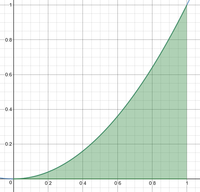Hckyplayer8
Full Member
- Joined
- Jun 9, 2019
- Messages
- 269
Jomo,No no no. Just like before you approximate the area using N rectangles and then you compute the limit as N-->\(\displaystyle \infty\)
(b-a)/n = (1-0)/N = 1/N.
Use the formula [MATH]\left \{ \sum_{j=0}^{n-1} f \left (a + j * \dfrac{b-a}{n} \right ) * \dfrac{b-a}{n} \right \}.[/MATH]
No no no. Just like before you approximate the area using N rectangles and then you compute the limit as N-->\(\displaystyle \infty\)
I do it just to confuse you but I will try to be better. Thanks for informing me about this.Jomo,
When you reply to a post - use the "reply" button inside the referenced post (bottom RHS corner). That will avoid the Khan-fusion regarding determination of "whose post are you responding to".
Your post above started with "No no no" - and I thought you are vehemently disagreeing with Mark's response (#2) just above your reply.
View attachment 14586
So the given is that the sum of the integral of f(x) = x2 over the interval [0,1] is 1/3. Thus the combined area of the left-endpoint rectangles = 1/3.
So my job is to figure out how many rectangles were used to come up with that summation?

